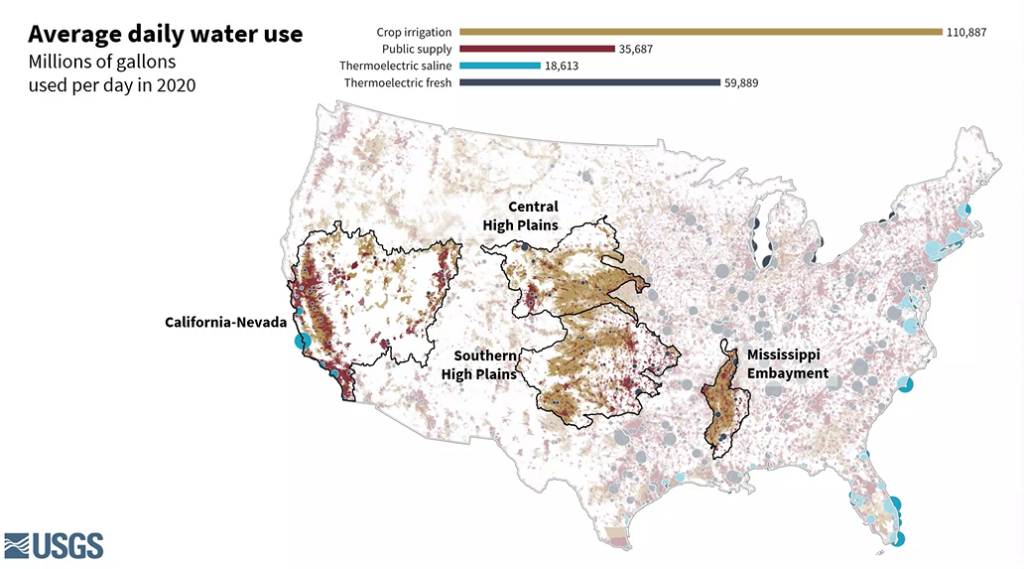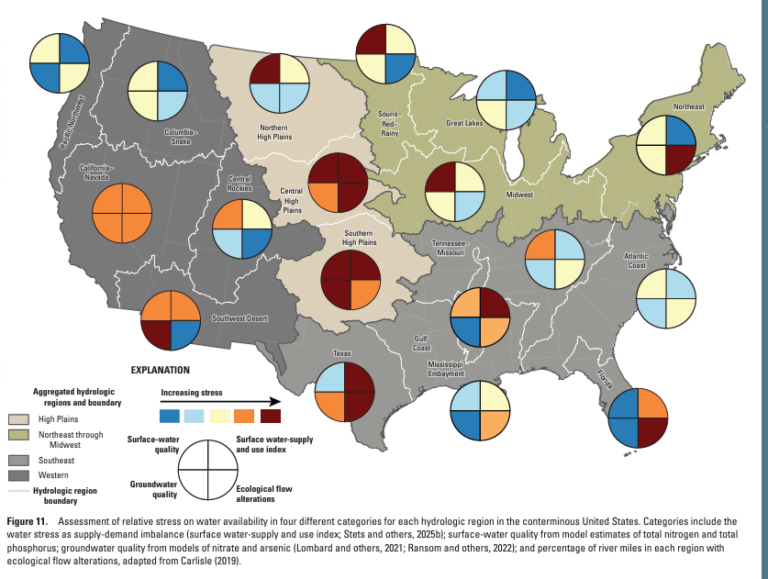Yves here. Virtually from the inception of this website, we warned that potable water would be the first resource to come under critical stress. as of then (mid 2000s) that was anticipated to occur around 2040. Places like Cape Town and Colorado-River dependent Southern California are already moving towards an acute phase. But poor people generally are the most exposed.
Now there are remedies of sorts, like desalination. But that comes at an energy and residue disposal cost.
By Carey Gillam. Originally published at The New Lede
Nearly 30 million people are living in areas of the US with limited water supplies as the country faces growing concerns over both water availability and quality, according to a new assessment by government scientists.
The US Geological Survey (USGS), which is part of the Department of the Interior, issued what it said was a first-of-its-kind report last week, with USGS Director David Applegate warning of “increasing challenges to this vital resource.” The Jan. 16 report, based on data from 2010 to 2020, examines not only water supplies but also demand patterns and water quality. The report showed that most of the country had supplies that exceeded demand during the period examined, but worrisome trends were noted.
“Water availability is an issue everywhere in our country and beyond,” Lori Sprague, USGS national program manager for the water availability assessment, said in a webinar presenting the report. “It raises the question – do we have enough water to sustain our nation’s economy, ecosystems and drinking water supplies?”

Among the key findings from the new analysis was that people who are considered “socially vulnerable” have a higher risk of experiencing limited water supplies. Overall, about 27 million people lived in areas where the USGS found a “high degree of local water stress.” And a higher proportion of the people living in those areas were considered socially vulnerable compared with those living in areas of more local water availability, the USGS said.
The report also added to evidence of widespread pollution in waterways across the US Midwest and High Plains regions where worrisome levels of nitrogen and phosphorus concentrations – tied in large part to large animal agriculture operations – can pose a threat to human health.
The USGS said that “substantial areas” of aquifers that provide about one-third of public water supplies have elevated concentrations of contaminants such as arsenic, manganese, radionuclides, and nitrate and that low-income and minority-dominated communities and people with domestic wells as their drinking water source experience increased exposure to this type of drinking water contamination.
Several regions were drawing on supplies that had percentages of concentrations of contaminants that exceed human health benchmarks for safety, the USGS reported.
And the USGS report reinforced concerns about climate change, saying that the “steady rise in global temperature as a result of human activity is causing changes in Earth’s water cycle.”
“The amount of water stored within and moving between vapor, liquid, and frozen components of the water cycle is shifting, with substantial consequences for water availability,” the USGS said.
Newly inaugurated President Donald Trump has expressed skepticism about climate change and already has started rolling back measures aimed at reducing the harmful impacts of the warming planet.
Climate changes that impact water availability include warmer and shorter winter seasons, extreme heat, drought, wind storms, reduced snow cover. The USGS noted that climate change impacts water quality as well, with threats to quality posed by rising water temperatures, flooding, and saltwater intrusion in coastal areas. In some places the balance between supply and demand is adequate but stream flow is altered in ways that are harmful to the local ecological community, the USGS said.
The agency cited three fish species that are “of conservation concern” and said that a large percentage of their habitat has been affected by water supply and use imbalances. One species, the Arkansas River shiner, had more than 50% of its habitat range in severe supply and use imbalance, for example.

The highest “interannual variability” in precipitation during the 2010–2020 period was noted in the California–Nevada, Texas, Southern High Plains, and the Southwest Desert hydrologic regions. And groundwater levels were found to be low in comparison to historical averages in key aquifers relied on by millions of people from California to the northern Atlantic coast.
The High Plains aquifers continued to show declines, which the USGS noted are part of a “long history of groundwater depletion in the region.” As well, a map of increasing stress on surface water supplies shows particularly dire conditions in the Central and Southern High Plains, and Texas.
Farmers irrigating crops remained the chief users of US water supplies, accounting for over 110 million gallons used per day, on average, in 2020, the USGS said.
The USGS has been estimating water use for decades, but hopes that its new modeling approaches will give it a more comprehensive understanding of water use across the US, officials said.


Just wait until Stargate gets rolling. Water shortages with brownouts..What fun.
Data center cooling is at the bottom of the water use priority list in Minnesota. Unfortunately Minnesota’s imperfect but best in the nation water regulations* are unique, meaning that everyone south and west of MN is screwed.
*- Wisconsin has a better constitutional basis (and mandate) for regulation but doesn’t have built in funding like MN making enforcement difficult to impossible due to GOP-inflicted austerity.
It would be nice to have a greater sense of clarity of who these ‘farmers’ are (family, domestic or foreign corporation, VC, etc) and also what sort of crops are grown.
Are the crops grown food, fodder or energy crops?
Fodder crops for recreational animals (horses) or for meat or dairy animals?
How much of US farming subsidies encourage the growing of water intensive crops?
if anyone has insight or can point to sources of information, that would be appreciated.
I doubt that a breakdown of farming — family, domestic or foreign corporation, VC, etc — would prove terribly informative in regard to the misuses of water, or its pollution. Farmers are in business to make a profit. I suspect the few who aren’t are becoming fewer. Similarly I doubt that a breakdown of types of produce, animal and plant, would offer much insight. The u.s. farming subsidies are as alterable as the subsidies to the petroleum cartels.
I can offer one source I ran across several years ago that might be modestly helpful. I cannot vouch for the bona-fides of the website — it is a little slick and omits mention of its sources of funding. Given those caveats you might find this posting from 2017 of some value: “Mystery Meat II”, https://mightyearth.org/article/heartlanddestruction/ along with the associated report at http://www.mightyearth.org/wp-content/uploads/2017/08/Meat-Pollution-in-America.pdf. I believe a root problem for u.s. agriculture is one of same root problems afflicting the preponderance of u.s. commerce, the unrestrained consolidation and monetary capture of u.s. government at all levels local, state, and federal. Change if it comes, will be cataclysmic, though so too will be the lack of change.
Here is a survey by USDA on irrigation that is part of the national agricultural statistics
https://www.nass.usda.gov/Publications/AgCensus/2022/Online_Resources/Farm_and_Ranch_Irrigation_Survey/index.php
I do not think the weird pie chart indications of fresh water issues in the various regions of the u.s. provide much in the way of information about just how serious fresh water supplies are and will be in the future … especially as the u.s. population will probably continue to grow at a fair clip even as the birth rates decline well below replacement level.
‘Agriculture’ is a big fresh water user, along with industry, and server farms. The water stored in u.s. aquifers is being drawn down and used up as fast as possible, much like other resource extraction. Many of the existing water resources have been and are being deliberately and inadvertently polluted — fracking, waste dumps, agricultural runoff, industrial waste dumping, mining slag, treatment and handling of human and animal sewage. The rising ocean waters sour coastal water tables.
The following notions suggest some interesting problems for the future:
“Humans are the only land animal that intentionally defecates in water.”
“Funny that defecating in drinkable water is not considered disgusting at all, even when potable water supply had dwindled to dangerous levels and was looking like it might dry up completely.” [p. 159, Humanure Handbook 4th Ed.]
The u.s. has adopted a peculiar way of wasting water using flush toilets. The way most Americans bath is also very wasteful of potable water. Car washes, Almond trees and lawns in the desert, the vast lakes of animal wastes; septic systems with their leach fields sometimes feeding waste into the water table; the acres of brown-fields polluted with toxic chemicals and heavy metals; the many many ways the u.s. wastes potable water and pollutes existing supplies of fresh water … the u.s. will have to make a lot of adjustments to its existing culture, capital, and ways if we intend that our grandchildren can get a drink of water when they are thirsty. The existing reservoirs and cisterns are inadequate considering the way rainfall has become so concentrated and random. Our future does not look bright.